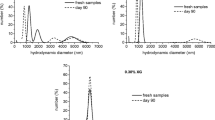Abstract
Purpose. Loading a liposomal dispersion with drug may cause a phase transformation into a micellar solution. The present contribution presents a detailed physicochemical characterization and an overall model which describes transformation due to the properties of any drug.
Methods. Characterization of liposomal dispersions was obtained by photon correlation spectroscopy (PCS) and small angle X-ray scattering (SAXS). Microstructure of colloidal solutions was analysed by 31P-NMR and SAXS.
Results. At weight ratios of phospholipid to drug from 16:1 to 2:1, liposomal dispersions of milky-white appearance and a mean particle size of about 200 nm were obtained. From a ratio of phospholipid to drug of 1:1 downwards, the systems became nearly transparent. The particle size decreased to a value below 25 nm. SAXS also revealed the change of the colloids. Down to a ratio of phospholipid to drug of 2:1 the systems were described as bilayer-structured. At and below the ratio of 1:1, a mixed micelle was indicated. In the 31P-NMR spectra, the transformation is emphasized by both appearance and disappearance of signals. A model based on the theory of self-assembly is presented which explains the phase transformation due to drug amphiphilicity.
Conclusions. We predict that the model presented will hold in general only due to the amphiphilic properties of the drug.
Similar content being viewed by others
REFERENCES
D. D. Lasic. Liposomes: From Physics to Applications, Elsevier, Amsterdam, 1993.
I. Papantoniou and C. C. Müller-Goymann. Influence of the phase transformation from reverse micellar solution into lamellar liquid crystal on sustained drug release. Pharm. Pharmcol. Lett. 1:28–31 (1995).
J. Röding. NatipideRII: New easy liposome system. SÖFW 116:509–516 (1990).
A. Fini, I. Orienti, A. Tartarini, L. Rodriguez, and V. Zecchi. Acta Pharm. Technol. 32:86–88 (1986).
K. Kriwet, Ph. D. Thesis, Diclofenac-Diethylamin und seine Assoziate mit Phospholipiden:Charakterisierung der Systeme und Einfluβ auf Struktur und Permeabilität humanen Stratum corneums, Technical University of Braunschweig, 1994.
O. Kratky. Neues Verfahren zur Herstellung von blendenstreuungsfreien Röntgenkleinwinkelaufnahmen. Z. Elektrochem. 58:49–53 (1954).
O. Glatter. Convolution square root of band-limited symmetrical functions and its application to small angle scattering data. J. Appl. Cryst. 14:101–108 (1981).
O. Glatter. Improvements in real-space deconvolution of small angle scattering data. J. Appl. Cryst. 17:435–441 (1984).
W. Schütze and C. C. Müller-Goymann. Small angle X-ray scattering (SAXS) — Application to colloidal systems. Pharm. Pharmacol. Lett. 6:23–26 (1996).
O. Glatter and O. Kratky. Small Angle X-ray Scattering, Academic Press, London, 1982.
M. F. Moody. Diffraction by dispersions of spherical membrane vesicles. I. The basic equations. Acta Cryst. A31:8–15 (1975).
K. Westesen and T. Wehler. Particle size determination of a submicron-sized emulsion. Colloids Surfaces A 78:125–132 (1993).
N. Franks and Y. K. Levine. Low angle X-ray diffraction. Mol. Biol. Biochem. Biophys. 31:437–487 (1981).
J. N. Israelachvili, D. J. Mitchell, and B. W. Ninham. Theory of self-assembly of hydrocarbon amphiphiles into micelles and bilayers. J. Chem. Soc. Faraday Trans. 72:1525–1565 (1976).
C. Tanford. The Hydrophobic Effect, John Wiley & Sons, New York, 1980.
H. Steffen. Lecture at the Kurs 502 of the Arbeitsgemeinschaft für Pharm. Verfahrenstechnik (APV), Nürnberg, Germany, 1990.
Author information
Authors and Affiliations
Rights and permissions
About this article
Cite this article
Schütze, W., Müller-Goymann, C.C. Phase Transformation of a Liposomal Dispersion into a Micellar Solution Induced by Drug-Loading. Pharm Res 15, 538–543 (1998). https://doi.org/10.1023/A:1011969524894
Issue Date:
DOI: https://doi.org/10.1023/A:1011969524894




